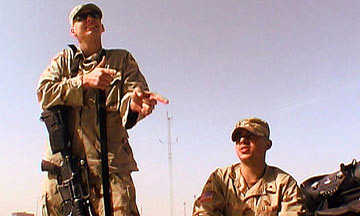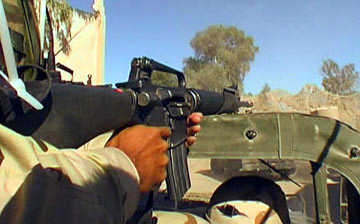Gunner Palace


As the overthrow of Saddam Hussein and the 2004 election move out of the recent memories of most filmmakers, the short burst of highly charged political documentaries begin to slow down. Gunner Palace is the first about Iraq in a while, and unlike most of the others released, has a fairly politically neutral viewpoint. Politics was not the point of directors Petra Epperlein and Michael Tucker (The Last Cowboy); they wanted to show what life was like for the average soldier; without an overt political spin by the filmmakers. The end product is sometimes compelling, but also surprisingly mundane (well, relatively so). The filmmakers did give themselves a heap of free publicity when they successfully re-rated the film from R to PG-13, arguing that while there was language and violence, it was important that older children be able to see what was in the film, and that Gunner Palace was not made for gratuitous reasons.
They have a point. One scary thought to remember is that many of the soldiers are fresh out of high school. They are nineteen and twenty, and war veterans. Even scarier is the fact that many soldiers are not doing what they were trained to do. Various NGOs and even some of the soldiers in Gunner Palace voice frustration that they are now doing things outside the scope of their original mission. They are directing traffic, and helping to build schools and mediating local disputes. These are all worthy projects, but is it truly effective for soldiers to run them? Worse, NGOs believe that by having the military run them, it blurs the line for insurgents between aid workers and soldiers. This can be very dangerous for aid workers.
The title of the film comes from the name of a partially destroyed palace that 2/3 Field Artillery lives in. The rumor is that Uday Hussein used to live in this monument to opulence. There, the soldiers can play in the pool, barbeque, or golf on a small putting green. It is a surreal contrast to their life outside the palace patrolling the streets, where danger lurks around every corner (keep in mind this is all after Bush's declaration that major combat had ended). Outside the palace is Adhamiya, a volatile Sunni suburb of Baghdad. Patrols through the streets are tense, with soldiers constantly worried about the possibility of attack. They stop traffic for potential IEDs only to have Iraqis laugh when they turn out to be harmless. At the same time, children wave and try to play with the soldiers.
Tucker also takes the camera along for some midnight raids on suspected insurgents, as well as a few of the most wanted criminals. Nothing ever happens according to plan. Sometimes, the most dangerous people go willingly with little resistance. Other times, Tucker captures images of allies turned enemy. And it's always baffling watching America soldiers shouting at civilian Iraqis, telling them to "get down!" in English (this is probably the third or fourth film to capture this) and getting angry when the Iraqis don't comply. Gee, maybe it's because they DON'T SPEAK ENGLISH?
Still, the heart of Gunner Palace lies with its soldiers, and the film works best when Tucker and Epperlein take time to interview them. They speak on camera of their hopes, fears, and frustrations. They are simply ordinary people in some very different circumstances. They talk about their kids, their love of Burger King, they create raps about their experiences, and goof off. The emotional center of the story is SPC Stuart Wilf, who probably has the most camera time. He's the type of person one imagines as the class clown, and sometimes comes off as funny, and sometimes very annoying. And in one extended monologue, he details how little has changed at home, while he's traveled across the world and fought in a war. But the point is that he's just a normal guy like the rest of them. Some voice their frustrations on camera, but there is a minimum amount of complaining.